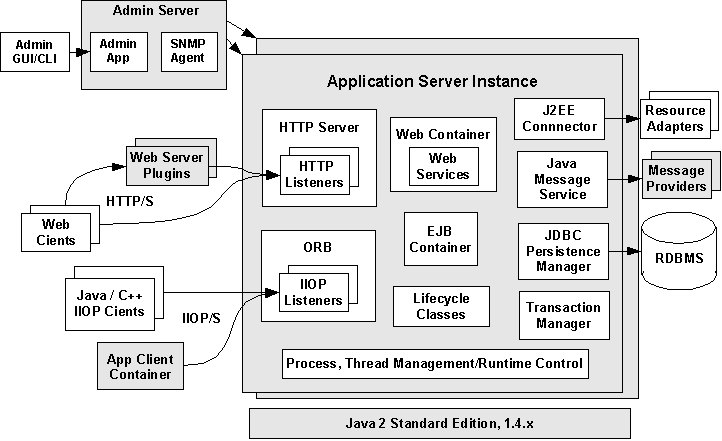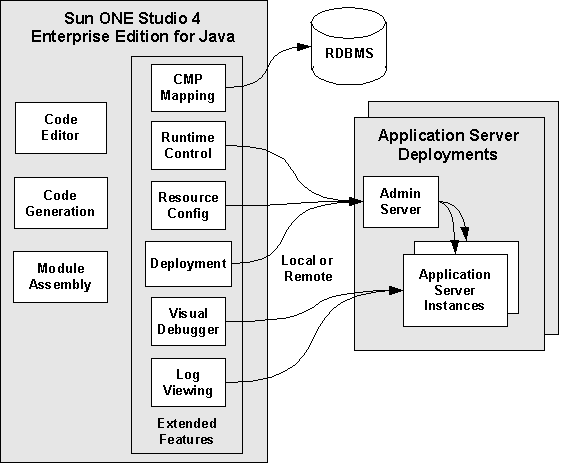|
|
| Sun ONE Application Server 7 Server Architecture Overview |
| 816-7143-10 |
| Updated: September 18, 2002 |
Architectural OverviewA Sun ONE Application Server 7 deployment consists of a number of application server instances, an administrative server and, optionally, one or more web server tier proxy plugins.
Sun ONE Application Server deployment

Application Server instances form the basis of an application server deployment. J2EE 1.3 web and EJB containers are included in each application server instance. A proven, high-performance HTTP server is built in and integrated with the web container. An Object Request Broker module (ORB) enables EJB invocation via RMI-IIOP. In support of access to backend systems, applications can leverage J2EE Connector Architecture support and third party Resource Adapters, JMS and either the built-in JMS provider or third-party providers, and any combination of popular third-party JDBC drivers. Access to backend systems can be managed within the scope of distributed transactions using the built-in, all-Java Transaction Manager.The Administrative Server houses the core administrative application and an SNMP agent. All remote management activity flows through the administrative server. Both command line and web browser based administrative clients access the administrative server directly either through HTTP or securely through HTTPS.
Web Sever Proxy Plugins enable you to deploy the application server behind one or more web servers housed in a demilitarized zone (DMZ) that is bracketed by one or more layers of firewalls. The plugins provide a means for the front end web server tier to direct incoming HTTP/S traffic received from the Internet to one or more application servers housed in a backend application server tier.
A variety of client applications can access business services deployed to the application server. Web service clients and browser-based clients can use either HTTP or HTTPS to access the web services, server-side end points and J2EE web applications. Java application clients can be deployed either in a standalone mode or within a standard Application Client Container and can use Java Remote Method Invocation over Internet Inter-ORB Protocol Technology (Java RMI-IIOP Technology) to access EJBs deployed to the application server. C++ language clients can use Java IDL/IIOP to access EJBs as well.
Development Integration
A key feature of Sun ONE Application Server 7 is its tight integration with the popular Sun ONE Studio 4, Enterprise Edition for Java Integrated Development Environment (IDE). Included with the application server is an integration module that extends key facets of Sun ONE Studio to further enhance developer productivity when working with the Sun ONE Application Server.
Sun ONE Application Server development integration

The Sun ONE Application Server integration module enhances key development features of Sun ONE Studio 4, Enterprise Edition for Java as described in the following table.
Deployment Topologies
Sun ONE Application Server 7, Platform and Standard Editions support both single machine and multi-machine, tiered deployments. No application server clustering or failover is supported in these editions. Standard Edition provides enhanced web tier support by allowing you to partition HTTP/S traffic arriving on the same web server instance to multiple application servers in the middle tier. This facility in the Standard Edition can be used to partition traffic to different application servers from the web server tier using the provided reverse proxy plugin. No load balancing from the plugin is supported in these editions.
While Platform Edition is limited to a single application server instance (i.e. a single JVM process) per administrative domain, the Standard Edition can be configured with multiple application server instances per administrative domain.
The Enterprise Edition supports multi-tiered, multi-machine, clustered application server deployments.
For more information, see the Sun ONE Application Server 7 documentation on http://docs.sun.com/.